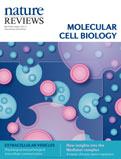|
Advertisement | |||||||||||||||||||||||||||||||||||||||||
| |||||||||||||||||||||||||||||||||||||||||
| TABLE OF CONTENTS | |||||||||||||||||||||||||||||||||||||||||
| April 2018 Volume 19 Number 4 | |||||||||||||||||||||||||||||||||||||||||
| In this issue
| | |||||||||||||||||||||||||||||||||||||||
| |||||||||||||||||||||||||||||||||||||||||
 | |||||||||||||||||||||||||||||||||||||||||
| Comment: A user's guide to the ambiguous word 'epigenetics' John M. Greally p207 | doi:10.1038/nrm.2017.135 The term 'epigenetics' is currently ambiguous, over-encompassing and uncoupled from its historical roots. This reflects interests and insights that have developed over time. In this Comment, I propose that we stop using the word in isolation, and be explicit about which definition we are using to avoid ambiguity in its scientific and public use. The term 'epigenetics' has multiple interpretations, so we need to be clear which definition we are using, argues John Greally. Full Text | PDF | |||||||||||||||||||||||||||||||||||||||||
| |||||||||||||||||||||||||||||||||||||||||
| Advertisement | |||||||||||||||||||||||||||||||||||||||||
| |||||||||||||||||||||||||||||||||||||||||
| REVIEWS | Top | ||||||||||||||||||||||||||||||||||||||||
| Shedding light on the cell biology of extracellular vesicles Guillaume van Niel, Gisela D'Angelo & Graça Raposo p213 | doi:10.1038/nrm.2017.125 Cells produce a wide variety of extracellular vesicles (subdivided into exosomes and microvesicles), which carry a multitude of cargoes, including proteins, lipids and nucleic acids. These vesicles have emerged as important means of cell-cell communication in physiology and disease, and their use in the clinic is now being explored. Abstract | Full Text | PDF | |||||||||||||||||||||||||||||||||||||||||
| Ten principles of heterochromatin formation and function Robin C. Allshire & Hiten D. Madhani p229 | doi:10.1038/nrm.2017.119 The assembly and maintenance of heterochromatin are carried out by distinct mechanisms that include factors that bind nascent transcripts to recruit chromatin-modifying enzymes. The resulting post-translational modifications on heterochromatic histones contribute to the regulation of development by restricting lineage-specific gene expression. Abstract | Full Text | PDF | |||||||||||||||||||||||||||||||||||||||||
| Chromatin dependencies in cancer and inflammation Ivan Marazzi, Benjamin D. Greenbaum, Diana H. P. Low & Ernesto Guccione p245 | doi:10.1038/nrm.2017.113 Gene expression programmes that are induced by inflammatory or oncogenic signals are controlled by shared chromatin regulators. Such chromatin dependencies are known to regulate oncogenes and inflammation-promoting genes and can be leveraged to combine and increase the effectiveness of immune-cell-based therapies with epigenetic therapies. Abstract | Full Text | PDF | Supplementary information | |||||||||||||||||||||||||||||||||||||||||
| Transcription regulation by the Mediator complex Julie Soutourina p262 | doi:10.1038/nrm.2017.115 The evolutionarily conserved mediator of RNA polymerase II transcription (Mediator) complex is a general regulator of transcription. Recent structural and functional studies have provided important insights into the mechanisms of transcription activation by Mediator and have also revealed a new function of this complex in genome organization and suggested that it could be therapeutically targeted in disease. Abstract | Full Text | PDF | Supplementary information | |||||||||||||||||||||||||||||||||||||||||
| |||||||||||||||||||||||||||||||||||||||||
| You have been sent this Table of Contents Alert because you have opted in to receive it. You can change or discontinue your e-mail alerts at any time, by modifying your preferences on your nature.com account at: www.nature.com/myaccount For further technical assistance, please contact our registration department For print subscription enquiries, please contact our subscription department For other enquiries, please contact our feedback department Springer Nature | One New York Plaza, Suite 4500 | New York | NY 10004-1562 | USA Springer Nature's worldwide offices: Macmillan Publishers Limited is a company incorporated in England and Wales under company number 785998 and whose registered office is located at The Campus, 4 Crinan Street, London, N1 9XW. © 2018 Macmillan Publishers Limited, part of Springer Nature. All Rights Reserved. |
 |









No comments:
Post a Comment